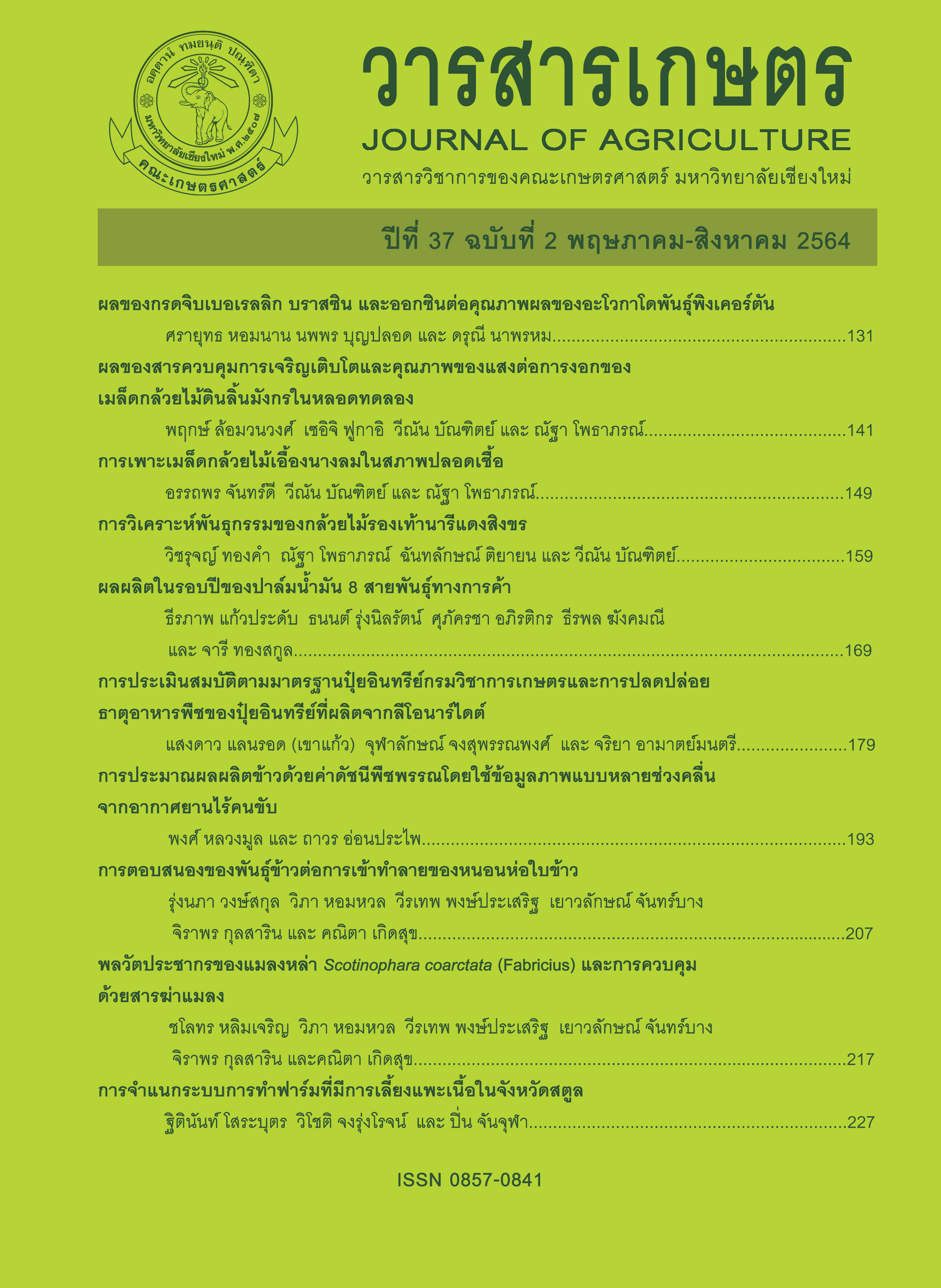การประมาณผลผลิตข้าวด้วยค่าดัชนีพืชพรรณโดยใช้ข้อมูลภาพแบบหลายช่วงคลื่นจากอากาศยานไร้คนขับ
Main Article Content
บทคัดย่อ
ข้อมูลภาพแบบหลายช่วงคลื่น จากอากาศยานไร้คนขับ (UAV) ของข้าวพันธุ์ชัยนาท 1 ในแปลงวิจัยที่ศูนย์วิจัยสาธิตและฝึกอบรมการเกษตรแม่เหียะ คณะเกษตรศาสตร์ มหาวิทยาลัยเชียงใหม่ ได้ถูกนำมาวิเคราะห์ค่าพารามิเตอร์การสะท้อนช่วงคลื่นของพืชในเชิงพื้นที่ด้วยโปรแกรมระบบสารสนเทศทางภูมิศาสตร์ (GIS) ในลักษณะค่าดัชนีพืชพรรณ (VI) 3 รูปแบบ และค่าตัวแปรร่วมทางกายภาพ 2 ค่า และถูกนำมาพัฒนาเป็นแบบจำลองในรูปแบบสมการถดถอยเชิงเส้นอย่างง่ายและพหุคูณเพื่อประมาณการผลผลิตข้าวในแปลงทดลองร่วมกับค่าผลผลิตข้าวที่ได้จากการตั้งแปลงเก็บเกี่ยว ผลการศึกษา พบว่า แบบจำลองที่น่าเชื่อถือมากที่สุดถูกพัฒนาด้วยค่าพารามิเตอร์การสะท้อนช่วงคลื่นของพืชทั้งหมดจากอากาศยานไร้คนขับในรูปแบบสมการถดถอยเชิงเส้นพหุคูณ คือ Y = -430.86 - 5108.88X1 - 447.9X2 + 2751.09X3 + 282.36X4 - 254.2X5 ด้วยค่าสัมประสิทธิ์การตัดสินใจ (R2) มากที่สุดเท่ากับ 0.879 ผลการทดสอบสรุปได้ว่าแบบจำลองสามารถให้ค่าประมาณการผลผลิตข้าวที่ใกล้เคียงกับค่าผลผลิตจริง สามารถใช้เป็นประโยชน์ต่อการพยากรณ์ผลผลิตข้าวในระดับแปลงได้เป็นอย่างดี
Article Details
เอกสารอ้างอิง
Bai, G., Y. Ge, W. Hussain, P.S. Baenziger and G. Graef. 2016. A multi-sensor system for high throughput field phenotyping in soybean and wheat breeding. Computers and Electronics in Agriculture 128: 181-192.
Barrero, O., D. Rojas, C. Gonzalez and S. Perdomo. 2016. Weed detection in rice fields using aerial images and neural networks. pp. 1-4. In: Proceedings of XXI Symposium on Signal Processing, Images and Artificial Vision IEEE, Bucaramanga.
Basso, B., D. Cammarano and E. Carfagna. 2013. Review of crop yield forecasting methods and early warning systems. (Online). Available: http://www.fao.org/fileadmin/ templates/ess/documents/meetings_and_ workshops/GS_SAC_2013/Improving_methods_for_crops_estimates/Crop_Yield_Forecasting_Methods_and_Early_Warning_Systems_Lit_review.pdf (December 18, 2020).
Chenga, C.-L., Shalabh and G. Garg. 2014. Coefficient of determination for multiple measurement error models. Journal of Multivariate Analysis 126: 137-152.
Department of Agriculture. 1993. Rice Varieties Chai Nat 1. Technical Documents. Thailand Rice Science Institute, Department of Agriculture, Bangkok. 20 p. (in Thai)
Gevaert, C.M., J. Tang, F.J. García-Haro, J. Suomalainen and L. Kooistra. 2014. Combining hyperspectral UAV and multispectral Formosat-2 imagery for precision agriculture applications. doi: 10.1109/WHISPERS.2014.8077607. In: Proceedings of 6th Workshop on Hyperspectral Image and Signal Processing: Evolution in Remote Sensing (WHISPERS), Lausanne.
Gitelson, A.A., Y.J. Kaufman and M.N. Merzlyak. 1996. Use of a green channel in remote sensing of global vegetation from EOS-MODIS. Remote Sensing of Environment 58(3): 289-298.
Grassi, M. 2014. Five actual uses for drones in precision agriculture today. (Online). Available: http://drone life.com/2014/12/30/5 -actual-uses-drones-precision-agriculture-today/ (June 20, 2020).
Guevara-Escobar, A., J. Tellez and E. Gonzalez-Sosa. 2005. Use of digital photography for analysis of canopy closure. Agroforestry Systems 65(3): 175-185.
Hunt, E.R., P.C. Doraiswamy, J.E. McMurtrey, C.S.T. Daughtry, E.M. Perry and B. Akhmedov. 2013. A visible band index for remote sensing leaf chlorophyll content at the canopy scale. International Journal of Applied Earth Observation and Geoinformation 21: 103-112.
Hunt, E.R., W.D. Hively, G.W. McCarty, C.S.T. Daughtry, P.J. Forrestal, R.J. Kratochvil, J.L. Carr, N.F. Allen, J.R. Fox- Rabinovitz and C.D. Miller. 2011. NIR-green-blue high-resolution digital images for assessment of winter cover crop biomass. GIScience and Remote Sensing 48(1): 86-98.
Jiang, Z., A.R. Huete, K. Didan and T. Miura. 2008. Development of a two-band enhanced vegetation index without a blue band. Remote Sensing of Environment 112(10): 3833-3845.
Krishna, K.R. 2018. Agricultural Drones: A Peaceful Pursuit. Apple Academic Press, Burlington. 412 p.
Land Development Department. 2006. Forecasting of Rice Yield in 2006 by Remote Sensing Technology and Geographic Information System. Technical Documents. Office of Soil Survey and Land Use Planning, Land Development Department, Bangkok. 402 p. (in Thai)
López-Pérez, A., M.R. Martinez-Menes and D.S. Fernández-Reynoso. 2015. Priorización de áreas de intervención mediante análisis morfométrico e índice de vegetación. Tecnología y Ciencias del Agua 6(1): 121-137.
Malambo, L., S.C. Popescu, S.C. Murray, E. Putman, N.A. Pugh, D.W. Horne, G. Richardson, R. Sheridan, W.L. Rooney, R. Avant, M. Vidrine, B. McCutchen, D. Baltensperger and M. Bishop. 2018. Multitemporal field-based plant height estimation using 3D point clouds generated from small unmanned aerial systems high-resolution imagery. International Journal of Applied Earth Observation and Geoinformation 64: 31-42.
Office of Agricultural Economics. 2019. Important Agricultural Product Situations and Trends in 2020. Final Report. Office of Agricultural Economics, Bangkok. 235 p. (in Thai)
Ren, J., Z. Chen, Q. Zhou and H. Tang. 2008. Regional yield estimation for winter wheat with MODIS-NDVI data in Shandong. China. International Journal of Applied Earth Observation and Geoinformation 10(4): 403-413.
Rouse, J.W., R.H. Haas, J.A. Schell and D.W. Deering. 1974. Monitoring vegetation systems in the Great Plains with ERTS, pp. 309-317. In: Proceedings of the Third Earth Resources Technology Satellite-1 Symposium. NASA, Washington, D.C.
Thompson, L.J., R.B. Ferguson, N. Kitchen, D.W. Frazen, M. Mamo, H. Yang and J.S. Schepers. 2015. Model and sensor-based recommendation approaches for in-season nitrogen management in corn. Agronomy Journal 107(6): 2020-2030.
Weier, J. and D. Herring. 2000. Measuring Vegetation (NDVI & EVI). (Online). Available: https://earthobservatory.nasa. gov/features/MeasuringVegetation (Sep 30, 2020).


